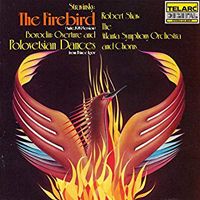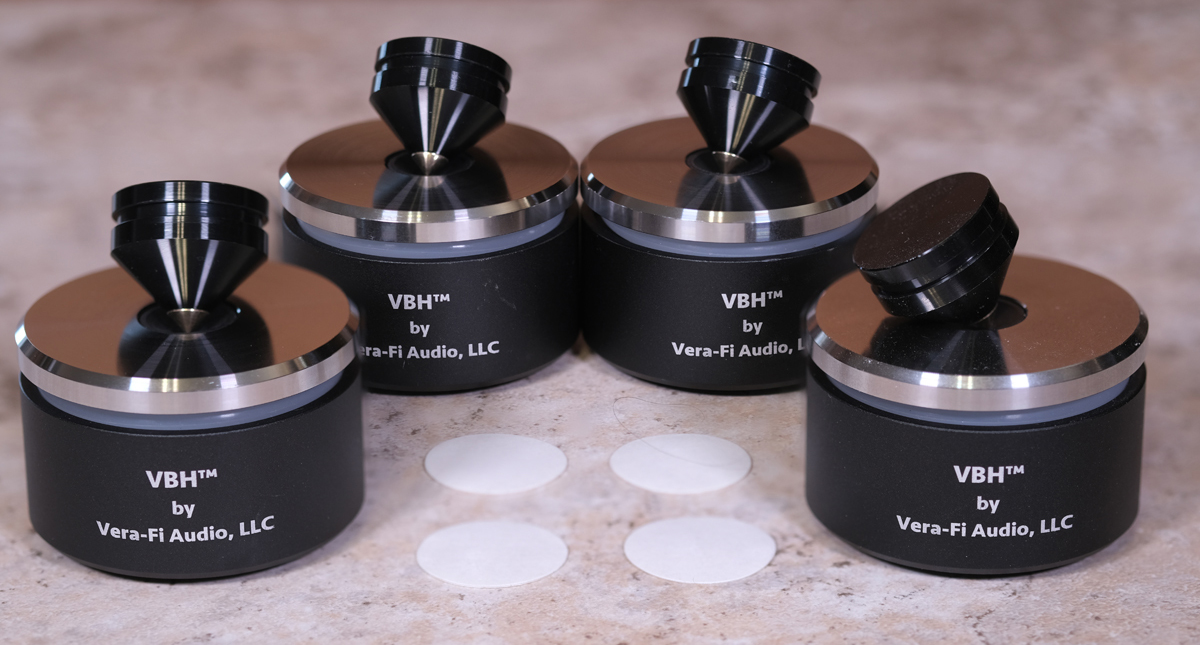This Christmas I received a gift in the form of the Vera-Fi Audio VBH-1 (Vibration Black Hole) which presented me with the opportunity to talk about and dispel many of the misunderstandings about isolation products, in specific cones, spikes, and dampers, as well as their proper uses for different audio components.

To begin with, there are two separate applications for these devices; electronics and speakers which have very different requirements.
Originally, isolation was a distinct need for turntables (and to a lesser extent other electro-mechanical sources, such as optical drives [CD Players] and magnetic drives [Tape Players]) as vibration can cause mistracking and even skipping, as well as a phenomenon known as rumble which is a feedback loop created by the turntable acting as a microphone (not unlike guitar feedback used as an effect) and picking up the sound from the speakers. As it turns out, all electronics are microphonic to some extent (amplifiers more so than say DACs but pretty much anything that passes audio signal), I suspect this is due to the electronics moving through the resident environmental magnetic fields, after all, we create electricity by passing a conductor through a magnetic field.
In the beginning, dampers were used in the form of suspension (usually springs) and rubber feet. The drawback to suspension was that while it isolated from the platform on which the device was placed, it turned the turntable itself into a diaphragm to capture free air resonance. While mass helped to curtail this, as anyone who has been in a car with bad shocks can attest, it opens the turntable up to low-frequency oscillation which can be worse than the mechanical resonance through the feet. As larger speakers capable of lower frequency reproduction and sub-woofers came into vogue this became a real problem and while some turntable manufacturers tried different forms of damping (shock absorbers if you will) others forwent suspension altogether.
Enter the cone. The cone isolates in two ways, one it minimizes the contact surface which in turn limits the amount of energy transferred, and two by its shape, the cone dissipates energy as it travels from the point to the large end, conversely, it focuses energy from the large end to the point creating a sort of mechanical diode (which may result in some waveform cancellation in itself, I don’t know) which usually is not an issue, though one can imagine that it might amplify a particularly noisy transformer or motor that is not properly isolated.
The final piece in our equation is the seat, which serves three functions, by virtue of being made from a hard material like the cone it again minimizes contact surface while at the same time providing a larger footprint which reduces horizontal movement (this will come up when we talk about speakers), and it protects your furniture from the point of the cone (which was the seat’s initial purpose).
Opponents of the cone will be quick to point out that it provides a direct mechanical connection for its resonance frequency (this is also true of dampers as every material has a resonance frequency, and as seen in the case of suspension systems resonance amplification can often be extreme in the absence of secondary suppression), but it should also be noted that the resonance frequency tends to be extremely high and unless the furniture and floor are also metal the nature of composite materials is the suppression of high frequencies.
Loudspeakers

The isolation demands of a loudspeaker are unique from those of other components as the loudspeaker is in fact the source of the sound that is being suppressed. Ideally, a loudspeaker would be suspended in mid-air at the desired height and held perfectly ridged, thus suppressing all uncontrolled resonance (sound) emanating from the speaker. Early on, many audiophiles would hang their speakers from the ceiling in order to achieve this isolation, but this approach fell afoul of Newtonian Physics in that a speaker is a mechanical device that imparts vibration to the surrounding air by moving a diaphragm back and forth, meaning a lot of the speaker’s energy was dissipated in moving the speaker back and forth. As it turns out, anchoring the speaker is more important than isolating the speaker, and the cone or spike were perfect for this when used in conjunction with carpet, the point still minimized the contact patch with the floor underneath while it also firmly anchored the speaker to the carpet. Of course, this did not work so well with hardwood or tile floors, but then again said floors also destroy the acoustics of the room so are not so appropriate for sound rooms anyway. Speaker manufacturers also found that directly coupling the speaker to the room often reinforced hard-to-reproduce low frequencies. The upshot is that most speaker manufacturers and audiophiles in general feel that speakers sound better on spikes, but as with all things audiophile-related, experimentation and prolonged listening are the only real way to tell if any technology works in a given environment.
The Vera-Fi Audio VBH-1

The Vera-Fi Audio VBH-1 combines all of the above-mentioned isolation techniques into a single compact composite package. To quote Vera-Fi Audio:
“The Vibration Black Hole (VBH) isolation feet provides mechanical vibration attenuation and isolation using a novel two-stage constrained viscous layer damping (CVLD) technique whereby a compliant and viscous polymeric medium is placed in between two hard surfaces, thereby providing a mechanical impedance mismatch that dissipates the energy from mechanical motions/vibrations through the mechanical shear and compression of the viscous layer. By use of dissimilar materials (nylon/stainless steel/viscous polymer/silicone rubber) in multiple stages, the VBH provides an exceptional level of extra mechanical dampening between two components needing mechanical isolation.
The VBH is ideal for mechanically isolating sensitive audio gear such as turntables, tube amplifiers, preamplifiers, and buzzing power supplies in large linear amplifiers. They are also very useful for isolating speakers from hard floors or tables to provide an improved soundstage and bass clarity. Each VBH consists of a precision machined stainless steel body and stainless steel inner core and a machined nylon piston-like conical contact pad. In between each of these components is the unique CVLD dampening compound. The device being isolated mounts on the included machined aluminum spike feet which mate to the nylon conical contact pads to provide the first stage of isolation. This stage is then in contact with the main external base through a second CVLD pad. The second stage of CVLD has an external backup silicone o-ring bumper to prevent bottoming out under heavy load and itself also acts as a CVLD under heavy loads.
Each VBH can support up to 30 lbs so a speaker with four VBH can weigh as much as 120 lbs. The VBH has been tested with an instrumented turntable plinth and special instrumented and calibrated test hammer and has shown a significant reduction in the transmitted mechanical shock and reduction in transmitted mechanical energy.”
By my count the VBH-1 has nine layers of isolation, you begin with the cone itself, which consists of a body, a tip, and an adhesive pad, you get the two benefits of the cone itself plus two levels of isolation due to its composite nature (there is energy loss between the body and the tip as well as the limited damping of the adhesive pad). Then there is the foot, which incorporates a nylon seat for the cone, composite material damping from the nylon seat to a steel plinth, the silicone shock absorber between the steel plinth and the steel body, the damping of the o-ring base, and the minimalized contact surface of the o-ring (the o-ring actually dampens in three ways, you have the basic material damping of rubber, the energy dispersal of a cone or ball, and the minimal single point contact of a ball, though extended for the full circumference of the o-ring) which gives us another five layers of isolation.
Returning to our loudspeaker discussion, the VBH-1 is ideal for use with hardwood or tile floors providing a seat for spikes or for the provided cones should the speakers not be fitted with spikes.
Living with the Vera-Fi Audio VBH-1
Ok, the rub is that unless you have a real environmental problem, like hardwood floors, or a particularly live room the effect of isolation systems is going to be subtle, and as I am not new to the game, I have already made accommodations where necessary, but it seems to me the items that would benefit most from the VBH-1 is my turntable, my tube amp, my tube preamp, and my speakers. It is a tossup whether their final resting place will be the turntable or the preamp since I already have a set of similarly designed feet I use for the table, but the VBH-1 are a definite step up. As I only have four Vera-Fi Audio VBH-1 isolation feet and six are required for a pair of speakers, my testing was limited using the aforementioned similar feet to balance out the difference.
The Equipment used for this review was my reference system consisting of my XSA-Labs Vanguard Loudspeakers, LSA VT-70 Tube Integrated Amp, Audible Illusions Modulus Preamp, Bang & Olufsen Beogram 4002 Turntable, Audio-gd R2R-1 DAC, Black Dragon Speaker Cables, and Core Power Technologies A/V Equi=Core 1000.

As expected the VBH-1 gave the speakers a slight boost in dynamics and tightened everything up a little. This was especially noticeable with my sub-bass test track “Can-utility And The Coastliners” (Genesis – “Foxtrot” – DSD)

On the other hand with the turntable and electronics the noise floor dropped which was mostly noticeable in an expanded soundstage. For these tests, I used my original vinyl copy of Telarc’s “Stravinsky: The Firebird; Borodin: Music from Prince Igor” as performed by Robert Shaw conducting the Atlanta Symphony Orchestra.
Conclusions on the Vera-Fi Audio VBH-1
The Vera-Fi Audio VBH-1 was extremely effective at vibration suppression and the most thorough in my experience in covering all the bases when it comes to suppression technology. I would highly recommend this product for tube amps and turntables even in personal audio systems as they can be highly susceptible to outside influences other than the music itself, and subtle changes in noise floor are especially noticeable in headphones, more so if they are closed back.
While I used them with stand-mounted speakers, they should be equally, if not more, effective with floor-standing speakers if you have hard floors.
Again, unless you have a specific issue that needs to be dealt with, isolation products are a tweak rather than an absolute necessity, but if you want to get the most out of your system they are a must, and I can think of no better recommendation than the Vera-Fi Audio VBH-1.
Price: $199
Manufacturer’s Website: www.verafiaudiollc.com















Want to join discussion?
Feel free to contribute!